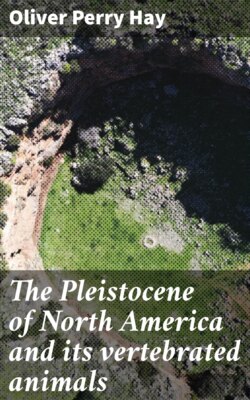Читать книгу The Pleistocene of North America and its vertebrated animals - Oliver Perry Hay - Страница 43
ILLINOIS.
Оглавление(Map 3.)
1. Urbana, Champaign County.—In the fall of 1909 a claw phalange of Megalonyx jeffersonii was found near Urbana by Mr. Lindley, of Urbana. An excavation was being made at the eastern end of Crystal Lake, and the tooth, as reported to the writer by Professor C. C. Adams, was discovered in a blue clay. The writer has seen the tooth. The extreme length in a straight line had been close to 145 mm. The greatest thickness was 42 mm. This has been figured by the writer (Iowa. Geol. Surv., vol XXIII, plate III, figs. 5, 6, text-figs. 28–29).
Inasmuch as all this region is covered by Wisconsin drift and this tooth was found in a deposit lying on the top of this drift, there can be no reason for denying that this species lived after, probably long after, the withdrawal of the Wisconsin ice. Two occurrences of the same species in Ohio confirm the conclusion.
2. Alton, Madison County.—The U. S. National Museum contains a fragment of a molar of apparently Megalonyx jeffersonii, from a collection made long ago by William McAdams, at Alton, Illinois. It has on it McAdams’s number 21. This collection, which was long in the hands of Professor O. C. Marsh, as vertebrate palæontologist of the U. S. Geological Survey, is said to have been made in the loess at Alton. Most of the teeth, with occasional bones, are inclosed in nodules of extremely fine sand and carbonate of calcium so hard that the teeth can not be removed without injury. They have been, however, partly exposed by weathering. The nodules which contained the fossils were found between the loess and the underlying Illinoian drift.
The fragment of a megalonyx tooth has the diameters respectively 16 mm. and 24 mm. It is thinner fore-and-aft than other specimens, but this may be an individual variation.
It is believed that this loess belongs to the Sangamon interglacial stage. The geology of the locality and the species found there are discussed on page 339. Also, the fossils were described by the writer in 1920 (Proc. U. S. Nat. Mus., vol. LVIII, pp. 109–117). The presence of this sloth-like beast appears to indicate that the climate was at that time mild.
3. Galena, Jo Daviess County.—In 1870 (Proc. Acad. Nat. Sci. Phila., 1870, p. 13), Dr. Leidy brought to the notice of the Academy the fossil remains of two species of much interest. These had been presented to the Academy by Henry Green, of Elizabeth, Jo Daviess County, and were reported as having been found in a narrow crevice of the lead-bearing rocks in the vicinity of Galena, at a depth of 130 feet. One fossil was a metacarpal bone of Megalonyx jeffersonii, the other was identified as a last lower molar of Bison antiquus. Leidy mentioned three other species, Platygonus compressus, Procyon priscus, and Anomodon snyderi as having been found about Galena in similar situations. The geological age of the Vertebrata found in the lead crevices about Galena has not been well determined, but the present writer has regarded them as being probably of late Wisconsin time. The Bison tooth may have been that of the yet existing species. However, the possibility is that these fossils are pre-Wisconsin.
